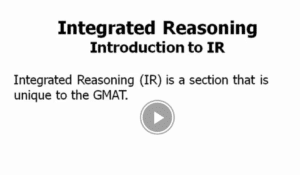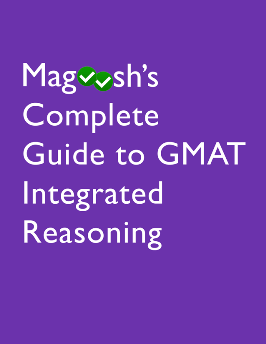
If you’re sitting down to your first GMAT Integrated Reasoning section, you might not know what to think! You’ll have 30 minutes to answer 12 Integrated Reasoning GMAT questions involving a ton of data analysis, critical thinking, and quantitative reasoning. But by preparing early—and thoroughly!—you’ll be able to get the Integrated Reasoning GMAT score that you want on test day.
What is GMAT Integrated Reasoning?
The GMAT Integrated Reasoning section tests your quant-based and verbal-based reasoning in 4 parts: multi-source reasoning, table analysis, two-part analysis, and graphics interpretation. Essentially, the GMAT IR section is testing for your data analysis skills.
The big question for many students: just what is the GMAT IR score importance? IR is relatively important (and increasingly so!), so it’s vital not to ignore it!
Overall, you can expect to see 12 questions in 30 minutes. It’s not quite as simple as it sounds, though: each graph or prompt will have multiple questions. In addition, you’ll have to answer a question before you can move on—and you can’t go back to a question once you’ve answered it.

Check out this video of Magoosh’s Introduction to Integrated Reasoning lesson!
Integrated Reasoning Question Types on the GMAT
Multi-Source Reasoning
Multi-source reasoning questions show you a split screen: on the left, you’ll have three clickable cards, each with a piece of information that will help you answer a particular question, and which you can only see one of at a time. The questions are either standard five-choice multiple choice or multiple dichotomous choice. You’ll have two answer choices (e.g. “true/false”) for each part of a three-part question.
For more sample multi-source reasoning problems, click here!
Table Analysis
Table analysis questions give you a sortable table of numbers. These are accompanied by multiple dichotomous choice questions, in which you have two answer choices (e.g. “true/false”) for each part of a three-part question.
Check out a sample table analysis problem!
Graphics Interpretation
For graphics interpretation questions, you’ll receive some visual information in the form of a chart or a graph, then questions containing two drop-down menus each. These menus will have you fill in blanks within a sentence according to the data shown in the visual.
Check out more sample graphics interpretation problems!
Two-Part Analysis
Two-part analysis questions give you a large prompt, followed by a question-and-answer table. You will fill out the answers for each of two questions, which can vary; they may be partially or completely related, but they will always be interdependent.
Check out a sample two-part analysis problem!
Strategies for Getting a Good Integrated Reasoning GMAT Score
Getting a good Integrated Reasoning GMAT score can be tricky—not least of all because a lot of people aren’t sure what a good IR score is! Unlike the total GMAT score, which is scored between 200 and 800, IR is scored between 1 and 8. Most people would consider a good score to be above the 50th percentile—in other words, better than half of test-takers’ scores. For IR, this is a 5 or higher.
So how do you get that good score of 5+ on GMAT IR? Here are a few keys to succeeding:
- Know the question formats by heart. IR questions can be—and in fact, are meant to be—overwhelming. By knowing the formats in advance, you’ll be setting yourself up for success. That’s one part of the section that won’t be overwhelming!
- Prepare yourself for strict time management. You get no partial credit for a question in IR. Furthermore, each of the 12 “questions” has multiple parts. So if you miss one part of a three-part question, you won’t get any points for that question at all. While 30 minutes for 12 questions sounds like a lot, 30 minutes for what can be 36 questions or more ends up being a whole lot less. Careful prep with timed practice is key!
- Get into an executive mindset. Executive function, that is, not business executive. These skills involve things like choosing priorities, evaluating benefits and liabilities, and coming up with strategies. Practice this by reading materials like The Wall Street Journal and The Economist to read and review different types of analyses.
- Work on your visual literacy. Charts and graphs are extremely important in GMAT IR! Again, The Wall Street Journal and The Economist can be incredibly helpful here. Make sure that you work not only on breaking down the parts of a graph, but also on understanding and analyzing them in context.
GMAT Integrated Reasoning Practice
Need Integrated Reasoning GMAT practice? You’re not alone! That’s why Magoosh is excited to present you with the ultimate GMAT Integrated Reasoning eBook: Magoosh’s Complete Guide to GMAT Integrated Reasoning! Here, you’ll find detailed explanations and tips for each IR question type, as well as practice witin each area.
Still want more? You can find Magoosh’s guide to the official GMAT Integrated Reasoning practice here!
A Final Note
GMAT Integrated Reasoning questions are designed to throw a lot of data at you, fast. And while a lot of test-takers will let that throw them off their game, you can ensure that you’re all set for test day by familiarizing yourself with these question types and practicing, practicing, practicing! The more used to the question types you are, the easier your test day experience will be. And the GMAT IR prep tools in this post will help you get there. Good luck!
The post Integrated Reasoning on the GMAT: The Complete Guide appeared first on Magoosh GMAT Blog.


